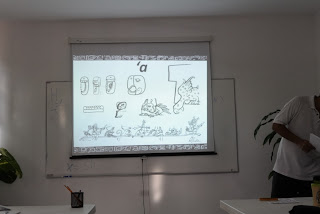We recently had a fantastic epigraphy workshop where we learned to decipher the hieroglyphic writing style of the Mayans. We learned that each part of a glyph can represent a word, idea, or simply a syllable.
First we looked at where the glyphs can be found (in books, incorporated into murals or on large pieces of stone that served as announcement boards of wars and new rulers). Then we learned a little bit about the process of deciphering these glyphs that were found hundreds of years after the Mayans stopped writing them.
And finally it was our turn to create our own! We used what we had learned about the phonetic properties of each component and tried out writing our own names, some of which had to be modified because certain sounds or combinations of letters don't exist in the Mayan language, like the "r," so Karla becomes Kala, etc.









